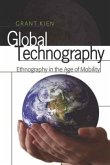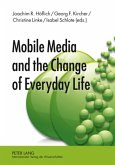The Cell Phone Reader
Essays in Social Transformation
Herausgegeben:Kavoori, Anandam; Arceneaux, Noah
The Cell Phone Reader
Essays in Social Transformation
Herausgegeben:Kavoori, Anandam; Arceneaux, Noah
- Broschiertes Buch
- Merkliste
- Auf die Merkliste
- Bewerten Bewerten
- Teilen
- Produkt teilen
- Produkterinnerung
- Produkterinnerung
The Cell Phone Reader offers a diverse, eclectic set of essays that examines how this rapidly evolving technology is shaping new media cultures, new forms of identity, and media-centered relationships. The contributors focus on a range of topics, from horror films to hip-hop, from religion to race, and draw examples from across the globe. The Cell Phone Reader provides a road map for both scholars and beginning students to examine the profound social, cultural and international impact of this small device.
Andere Kunden interessierten sich auch für
![Global Technography Global Technography]() Grant KienGlobal Technography32,95 €
Grant KienGlobal Technography32,95 €![Global Technography Global Technography]() Grant KienGlobal Technography72,99 €
Grant KienGlobal Technography72,99 €![Communication Ethics, Media, and Popular Culture Communication Ethics, Media, and Popular Culture]() Communication Ethics, Media, and Popular Culture36,55 €
Communication Ethics, Media, and Popular Culture36,55 €![Remote Relationships in a Small World Remote Relationships in a Small World]() Remote Relationships in a Small World94,95 €
Remote Relationships in a Small World94,95 €![Remote Relationships in a Small World Remote Relationships in a Small World]() Remote Relationships in a Small World40,50 €
Remote Relationships in a Small World40,50 €![The (Dis)information Age The (Dis)information Age]() Shaheed Nick MohammedThe (Dis)information Age105,95 €
Shaheed Nick MohammedThe (Dis)information Age105,95 €![Mobile Media and the Change of Everyday Life Mobile Media and the Change of Everyday Life]() Mobile Media and the Change of Everyday Life74,60 €
Mobile Media and the Change of Everyday Life74,60 €-
-
-
The Cell Phone Reader offers a diverse, eclectic set of essays that examines how this rapidly evolving technology is shaping new media cultures, new forms of identity, and media-centered relationships. The contributors focus on a range of topics, from horror films to hip-hop, from religion to race, and draw examples from across the globe. The Cell Phone Reader provides a road map for both scholars and beginning students to examine the profound social, cultural and international impact of this small device.
Produktdetails
- Produktdetails
- Digital Formations 34
- Verlag: Peter Lang
- Artikelnr. des Verlages: 67919
- 1. Auflage
- Seitenzahl: 254
- Erscheinungstermin: 14. März 2006
- Englisch
- Abmessung: 230mm x 160mm x 14mm
- Gewicht: 395g
- ISBN-13: 9780820479194
- ISBN-10: 0820479195
- Artikelnr.: 23246909
- Herstellerkennzeichnung
- Lang, Peter GmbH
- Gontardstraße 11
- 10178 Berlin
- r.boehm-korff@peterlang.com
- Digital Formations 34
- Verlag: Peter Lang
- Artikelnr. des Verlages: 67919
- 1. Auflage
- Seitenzahl: 254
- Erscheinungstermin: 14. März 2006
- Englisch
- Abmessung: 230mm x 160mm x 14mm
- Gewicht: 395g
- ISBN-13: 9780820479194
- ISBN-10: 0820479195
- Artikelnr.: 23246909
- Herstellerkennzeichnung
- Lang, Peter GmbH
- Gontardstraße 11
- 10178 Berlin
- r.boehm-korff@peterlang.com
The Editors: Anandam Kavoori is Associate Professor of Telecommunications and Director of The Cultural Technologies Project at the University of Georgiäs Grady College of Journalism and Mass Communication. In addition to his scholarly work in media theory and international communication, Dr. Kavoori has been a consultant for News Corporation, CNN International, and the Discovery Channel, and he was a key player in the start up of Indiäs first two 24-hour news channels, Aaj Tak News and Star News. Noah Arceneaux has an M.A. in American studies from the Graduate Center at the City University of New York and is a Ph.D. candidate in the University of Georgiäs Grady College of Journalism and Mass Communication. His work has been published in a range of academic journals, and he has developed websites for the ABC, CBS, and Fox networks.
Contents: Anandam Kavoori/Noah Arceneaux: Introduction - Paul Levinson: The Little Big Blender: How the Cellphone Integrates the Digital and the Physical, Everywhere - Adriana de Souza e Silva: Interfaces of Hybrid Spaces - Janey Gordon: The Cell Phone: An Artifact of Popular Culture and a Tool of the Public Sphere - Rich Ling: Life in the Nomos: Stress, Emotional Maintenance, and Coordination via the Mobile Telephone in Intact Families - Wendy Robinson/David Robison: Tsunami Mobilizations: Considering the Role of Mobile and Digital Communication Devices, Citizen Journalism, and the Mass Media - Collette Snowden: Cstng A pwr4l spLL: D evOLshn f SMS (Casting a Powerful Spell: The Evolution of SMS) - Allison Whitney: Can You Fear Me Now?: Cell Phones and the American Horror Film - Heidi Campbell: Texting the Faith: Religious Users and Cell Phone Culture - Gerard Goggin/Christopher Newell: Disabling Cell Phones - Davin Heckman: «Do You Know the Importance of a Skypager?»: Telecommunications, African Americans, and Popular Culture - Bahíyyih Maroon: Mobile Sociality in Urban Morocco - Paul Leonardi/Marianne E. Leonardi/Elizabeth Hudson: Culture, Organization, and Contradiction in the Social Construction of Technology: Adoption and Use of the Cell Phone across Three Cultures - Anandam Kavoori/Kalyani Chadha: The Cell Phone as a Cultural Technology: Lessons from the Indian Case.
Contents: Anandam Kavoori/Noah Arceneaux: Introduction - Paul Levinson: The Little Big Blender: How the Cellphone Integrates the Digital and the Physical, Everywhere - Adriana de Souza e Silva: Interfaces of Hybrid Spaces - Janey Gordon: The Cell Phone: An Artifact of Popular Culture and a Tool of the Public Sphere - Rich Ling: Life in the Nomos: Stress, Emotional Maintenance, and Coordination via the Mobile Telephone in Intact Families - Wendy Robinson/David Robison: Tsunami Mobilizations: Considering the Role of Mobile and Digital Communication Devices, Citizen Journalism, and the Mass Media - Collette Snowden: Cstng A pwr4l spLL: D evOLshn f SMS (Casting a Powerful Spell: The Evolution of SMS) - Allison Whitney: Can You Fear Me Now?: Cell Phones and the American Horror Film - Heidi Campbell: Texting the Faith: Religious Users and Cell Phone Culture - Gerard Goggin/Christopher Newell: Disabling Cell Phones - Davin Heckman: «Do You Know the Importance of a Skypager?»: Telecommunications, African Americans, and Popular Culture - Bahíyyih Maroon: Mobile Sociality in Urban Morocco - Paul Leonardi/Marianne E. Leonardi/Elizabeth Hudson: Culture, Organization, and Contradiction in the Social Construction of Technology: Adoption and Use of the Cell Phone across Three Cultures - Anandam Kavoori/Kalyani Chadha: The Cell Phone as a Cultural Technology: Lessons from the Indian Case.








